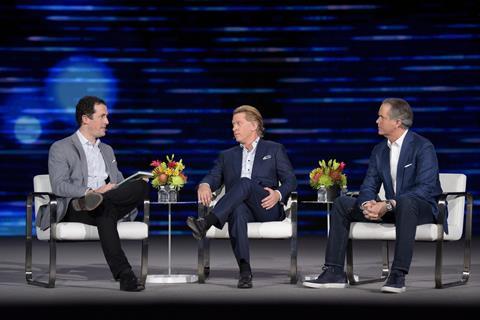Changes in viewing habits have led to some uncomfortable headlines for broadcasters, and now some media bosses are proclaiming 2018 as the year for rebuilding business models.
In the summer of 2017, the unthinkable happened: a TV show wasn’t watched by anyone. A repeat of UK children’s magazine show Blue Peter apparently didn’t have a single viewer, which added fuel to the debate as to whether linear TV is on its way out.

The upcoming generation of viewers does seem to be moving away from linear TV. According to a report by broadcast regulator, Ofcom, viewing of broadcast TV by children (four to 15 years old) and 16- to 24-year-olds fell 33% between 2010 and 2016, and about 9% compared with 2015. Nielsen also found that 18 - 24-year-old viewers were watching 25 minutes less TV per day than before, showing these viewers are disinterested in traditional television.
However, their interest has turned to on-demand, meaning that the rise of Amazon, Netflix and Hulu has come to the forefront.
During CES 2018, Randy Freer, CEO of Hulu, alongside John Martin, CEO and Chairman of Turner, talked about the opportunities presented to his company: “Here at Hulu, we’re incredibly excited about the opportunity to compete against the biggest companies in the world.
“Hulu has access to $30million worth of content and our goal is to delight customers with entertain, sports, news experience both on-demand and live, with and without ads, which gives consumers the choice and the opportunity to control their experience.”
Jointly owned by Disney, Fox, Comcast, and Turner, Hulu had more than 17 million subscribers at the end of 2017. That’s across its subscription-video-on-demand platform, which costs $7.99 a month ($11.99 without commercials), and the $39.99-a-month live-TV bundle that launched last year. However, it is behind players such as Netflix and Amazon Prime Video.

But the main differentiator, in the mind of Martin, is that Hulu is offering a live-TV bundle and content from several different partners.
He said: “Large digital companies are doing well, but, at their core, they are utility companies.” He also believes that consumers “do not have a relationship with their shopping basket”, paving the way for companies like Hulu to create experiences that retain users.
But consumer behaviour over the years have also contributed to the fall of linear TV. Research by MediaCom showed that a third of teenagers regularly view TV content via a smartphone, significantly more than the 25% who did so in 2016. Alongside this, teenagers are increasingly choosing to watch TV using on-demand services, with 38% selecting this as their most common way to view, higher than the 35% who watch most of their TV live. Binge-watching has also contributed, with viewers choosing to watch multiple episodes at a time, rather than watching an episode a week.
Josh Krichefski, CEO of MediaCom UK, commented: “Mobile and on-demand services have changed viewing patterns of everyday consumers.
“Whilst 84% of young people regularly watch live programming on TV, the explosion of streaming services such as NowTV and Amazon Instant Video shows that ‘live’ is no longer the only way kids watch. Consumers now have an even greater choice of when, where and how to watch their favourite videos, shows and movies – and the shift towards smartphone viewing is increasing. On-demand capabilities are critical to the popularity of shows for adults like Game of Thrones.”
Carl Hibbertson, Associate Director - Consumer Media & Tech at Futuresource, also thinks that focus needs to move away from the television set, following comments made by TV manufacturers during CES that the television set is the go-to content hub.
“It’s difficult to make TV the hub,” he explains. “It’s a shared experience.
“2018 is the year where we rebuild the business model - consumers will have access to what they want and need, where they want it.”
This trend has also been noticed by Hulu and Turner.
“The average of our subscribers is 31 years old, so that’s typically younger than broadcasters in the market,” says Freer. “What we have to do is create experiences for them that is original and that matters.”
Martin concurs and talked to his audience at CES about how Turner’s CNN has moved beyond linear TV to capture younger audiences.

“We reach 70% of millennials in the US, which no other broadcaster does,” says Martin. “CNN is engaging fans in the way fans want to consume news, which is incredibly different on your age demographic.
“The average age of our linear TV channel fans is the lower 50s, the desktop app is lower-40s, the app is 32, and people who consume CNN on Snapchat, like my 20-year old daughter, the average age is 24.
“So CNN is reaching all different ages but it is a very different and optimised experience.”
Freer also highlighted: “One of the downsides of having 486 channels is that people can set the bar high of what they want to watch.
“The expectation for content is so through the roof, and determining what is truly a hit or quality content, it’s a high bar at this point in time.”
Freer also warns broadcasters that while on-demand services, combined with live-TV will attract consumers, retaining them means not relying on one hit: “Hits are great - good TV is better than bad TV, but I don’t think anyone really knows what makes bad TV.
“To everyone the challenge is, it’s not what it used to be like for the studios - they used to have one hit that paid for everything,” he continues. “But, especially now when everyone binge-watches, when that show is over, you need to give them something else - you can’t wait two years to bring back the next version of that series.”
So is it all doom and gloom for traditional broadcasters? Martin doesn’t think so: “Aside from the clutter, if you can find a fan, you have to attach to them and continue to provide them with the type of content that will keep them engaged.
“I read somewhere that nine out of ten Americans consider themselves to be a fan of something, and eight of the nine identify themselves as being a fan of at least five things,” he continues. “Fandom is about self-identity, self-expression - these people evangelise, socialise and they advocate, so there is so much free marketing for businesses.
“That’s they have to start transitioning away from what’s traditional and go for reach and attention.”
When the zero-rating episode of Blue Peter was reported on, the BBC, unsurprisingly, issued
Indeed, when the episode had its first airing it was watched by some 53,100 (rising to a total of 252,000 people across all broadcasts). But it had also been played 39,000 times on the BBC’s OTT service iPlayer, while the show’s website was visited by 1.5m children over a six month period.
The audiences are out there, broadcasters just have to find new and innovative ways to engage with them.
























No comments yet